A Complete Guide to Building a Chabot Using Gemini API
Enter the Gemini API on Google Cloud Platform (GCP), a game-changing solution for building intelligent chatbots. Powered by advanced language models, including conversational AI, text summarization, and question-answering capabilities. Gemini API offers unparalleled versatility and performance in all streams. This guide aims to provide a comprehensive walkthrough on leveraging the Gemini API to build powerful chatbots on GCP. From setting up your environment to implementing advanced features and scaling deployments, we'll cover everything you need to know to harness the full potential of the Gemini API for creating next-generation chatbots.
Understanding the Gemini API
The Gemini API, part of Google Cloud's Vertex AI platform, stands as a powerful resource for constructing sophisticated chatbots. By harnessing Large Language Models (LLMs), this API empowers developers with a suite of capabilities essential for creating intelligent conversational interfaces.
At its core, the Gemini API facilitates natural language understanding, enabling chatbots to interpret and respond to user queries in a human-like manner. This functionality extends to diverse tasks, including text summarization, question answering, and text generation, ensuring a comprehensive approach to communication.
Hosted within Google Cloud's Vertex AI platform, the Gemini API benefits from the robust infrastructure and scalability offered by Google's cloud services. This integration with the Google Cloud ecosystem ensures seamless performance and reliability for chatbot applications, making it a preferred choice for developers seeking to deploy advanced conversational agents.
Furthermore, the Gemini API streamlines the development process by providing a RESTful interface for integration with existing systems and applications. This REST API simplifies the process of building, deploying, and managing chatbots, allowing developers to focus on enhancing user experiences and functionality.
Know the Key Features of Gemini
Discover the transformative power of Gemini API, Google's cutting-edge solution for building intelligent chatbots. In this guide, we'll explore the key features and capabilities of Gemini, along with practical insights on integrating it into your chatbot projects. Unlock the potential of conversational AI with Gemini API integration on Google Cloud.
1. Conversational AI: Gemini, powered by Google Cloud's chatbot API, empowers chatbots to engage in natural, open-ended conversations with users. Through advanced language understanding, it comprehends user queries and responds conversationally, enhancing user interaction and satisfaction.
2. Text Summarization: Leveraging the Gemini REST API, chatbots can summarize large bodies of text into concise and coherent summaries. This capability enhances content comprehension by extracting key points, enabling users to grasp essential information quickly.
3. Question Answering: With Google Cloud's Gemini chatbot API integration, chatbots excel at providing accurate and relevant answers to user queries. By accessing knowledge bases or text passages, Gemini swiftly retrieves information, offering valuable insights and solutions to user inquiries.
4. Text Generation: Gemini's REST API facilitates the generation of creative and engaging text formats, including poems, scripts, and emails. By integrating with Google Cloud's chatbot API, chatbots can craft personalized content tailored to user preferences, driving user engagement and satisfaction.
Now, let's discuss the capabilities of Google's Gemini.
Getting to Know the Capabilities of Gemini
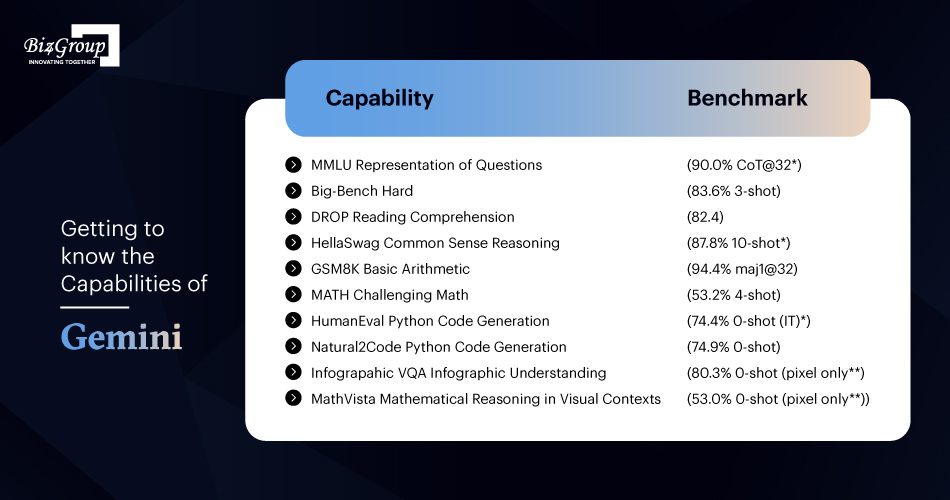
As artificial intelligence (AI) continues to advance, the demand for sophisticated language models capable of handling diverse tasks is on the rise. In this landscape, the Gemini API stands out as a powerful tool, offering a wide range of capabilities for building intelligent chatbots and enhancing conversational interfaces.
Leveraging the Gemini API, developers can create chatbots that excel in natural language understanding, text summarization, question answering, and more. This guide explores the capabilities of the Gemini API in detail, providing insights into its benchmarks and performance across various tasks. Let's delve into the world of building chatbots using the Gemini API and unlock its potential for transforming human-computer interactions.
1. CAPABILITY: MMLU Representation of questions in 57 subjects (incl. STEM, humanities, and others)
BENCHMARK: 90.0% CoT@32*
The Gemini Ultra excels in representing questions across 57 subjects, including STEM, humanities, and various other disciplines. With an impressive benchmark of 90.0% in CoT@32*, it demonstrates superior performance in understanding and processing a wide range of questions, showcasing its versatility and adaptability across diverse subject areas.
2. CAPABILITY: Big-Bench Hard Diverse set of challenging tasks requiring multi-step reasoning
BENCHMARK: 83.6% 3-shot
Gemini Ultra tackles challenging tasks requiring multi-step reasoning with an 83.6% success rate in the Big-Bench Hard benchmark. This capability allows it to handle complex tasks effectively, demonstrating its proficiency in reasoning and problem-solving across a variety of scenarios and challenges.
3. CAPABILITY: DROP Reading comprehension (F1 Score)
BENCHMARK: 82.4
With an F1 score of 82.4 in DROP reading comprehension, Gemini Ultra exhibits exceptional performance in comprehending and answering questions based on textual passages. This capability is crucial for tasks requiring a deep understanding of written content, making Gemini Ultra an ideal choice for applications such as educational assistance and information retrieval.
4. CAPABILITY: HellaSwag Common sense reasoning for everyday tasks
BENCHMARK: 87.8% 10-shot*
Gemini Ultra demonstrates strong common sense reasoning abilities, achieving an 87.8% success rate in the HellaSwag benchmark. This capability enables it to understand and respond appropriately to everyday tasks and scenarios, enhancing its usefulness in real-world applications such as virtual assistants and interactive chatbots.
5. CAPABILITY: GSM8K Basic arithmetic manipulations (incl. Grade School math problems)
BENCHMARK: 94.4% maj1@32
Gemini Ultra excels in basic arithmetic manipulations and grade school math problems, achieving an impressive 94.4% accuracy rate in the GSM8K benchmark. This capability enables it to accurately solve mathematical equations and perform calculations, making it invaluable for applications requiring mathematical reasoning and problem-solving.
6. CAPABILITY: MATH Challenging math problems (incl. algebra, geometry, pre-calculus, and others)
BENCHMARK: 53.2% 4-shot
Gemini Ultra demonstrates competence in solving challenging math problems, including algebra, geometry, and pre-calculus, with a 53.2% success rate in the MATH benchmark. While not as high as some other benchmarks, this performance still showcases its ability to handle complex mathematical tasks, making it suitable for applications requiring advanced mathematical reasoning.
7. CAPABILITY: HumanEval Python code generation
BENCHMARK: 74.4% 0-shot (IT)*
Gemini Ultra exhibits proficiency in generating Python code, achieving a 74.4% success rate in the HumanEval benchmark. This capability enables it to generate code snippets accurately based on given inputs, demonstrating its usefulness in automating programming tasks and assisting developers in writing code more efficiently.
8. CAPABILITY: Natural2Code Python code generation. New dataset HumanEval-like, not leaked on the API web
BENCHMARK: 74.9% 0-shot
Gemini Ultra continues to impress in Python code generation, achieving a 74.9% success rate in the Natural2Code benchmark. This capability allows it to generate Python code based on new, previously unseen datasets, highlighting its adaptability and robustness in handling diverse programming tasks and scenarios.
9. CAPABILITY: Infographic VQA Infographic understanding
BENCHMARK: 80.3% 0-shot (pixel only**)
Gemini Ultra demonstrates its proficiency in infographic understanding with an 80.3% success rate in the Infographic VQA benchmark. This capability enables it to analyze and comprehend visual information presented in infographics, making it valuable for tasks such as data visualization, infographic summarization, and visual data analysis.
10. CAPABILITY: MathVista Mathematical reasoning in visual contexts
BENCHMARK: 53.0% 0-shot (pixel only**)
With a 53.0% success rate in the MathVista benchmark, Gemini Ultra showcases its ability to perform mathematical reasoning in visual contexts. This capability allows it to solve mathematical problems presented in visual formats, making it useful for applications such as educational technology, interactive learning platforms, and math-based games.
Gemini Ultra's performance across these diverse capabilities highlights its versatility and competence in handling multimodal tasks, making it a powerful tool for various applications in artificial intelligence, image understanding, and natural language processing.
Use Cases for Chatbots Powered by Gemini API
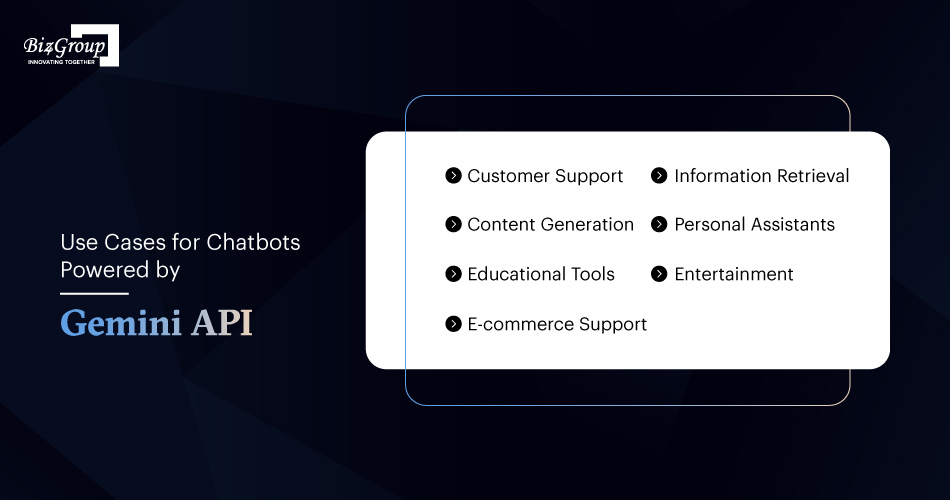
Chatbots have become indispensable tools for businesses seeking to enhance customer engagement, streamline processes, and deliver personalized experiences. Leveraging advanced artificial intelligence (AI) technologies, such as the Gemini API provided by Google Cloud, businesses can build powerful chatbots capable of conversing naturally, retrieving information instantly, and generating content autonomously.
This section explores the use cases of chatbots using the Gemini API, integrating it seamlessly into the Google Cloud ecosystem. From understanding the Gemini API to implementing various use cases, this guide equips businesses with the knowledge and tools needed to harness the full potential of AI-driven chatbots.
1. Customer Support: Gemini-powered use cases of chatbots in customer support, integrated with Google Cloud's chatbot API, streamline customer interactions by offering real-time assistance with product inquiries, technical support, and issue resolution. Businesses can use Gemini's capabilities to provide personalized and efficient support experiences, enhancing customer satisfaction and loyalty.
2. Information Retrieval: Google Cloud's chatbot development API, powered by Gemini's question-answering capabilities, enables chatbots to retrieve instant and accurate answers to user queries. Whether users seek information on products, services, or general knowledge, the chatbot can swiftly provide relevant responses, improving user engagement and satisfaction.
3. Content Generation: Integrating Gemini API into chatbots facilitates automated content creation, including summarizing articles, generating blog posts, and crafting marketing copy. Businesses can leverage this capability to streamline content production processes, maintain consistency across communication channels, and deliver timely and relevant content to their audience.
4. Personal Assistants: With Gemini API integration, chatbots can function as personal assistants, helping users manage tasks, appointments, and reminders seamlessly. By leveraging Google Cloud's chatbot API, businesses can offer users personalized assistance, optimize time management, and enhance productivity in various aspects of their daily lives.
5. Educational Tools: Gemini-powered chatbot use cases in education, integrated with Google Cloud's chatbot API, serve as valuable educational tools by providing explanations, answering questions, and offering personalized learning experiences to users. Educators and learners can leverage chatbots to access educational content, receive tutoring assistance, and engage in interactive learning activities.
6. E-commerce Support: Gemini-powered chatbots, integrated with Google Cloud's chatbot API, enhance the e-commerce experience by guiding users through the shopping process, recommending products based on preferences and purchase history, and providing updates on order status and delivery. Through personalized assistance and seamless navigation, businesses can drive sales and improve customer satisfaction. Various eCommerce chatbots can improve your business efficiencies and open paths toward success by focusing on the use cases of AI in eCommerce.
7. Entertainment: Chatbots powered by Gemini API, integrated with Google Cloud's chatbot API, entertain users with interactive storytelling, games, and quizzes. Leveraging Gemini's text generation capabilities, businesses can create engaging and immersive experiences that captivate users and increase user retention for more entertainment.
Exploring these diverse use cases demonstrates the versatility and effectiveness of chatbots development using Gemini API integrated with Google Cloud's chatbot API, enabling businesses to deliver personalized, efficient, and engaging experiences across various domains. Now, let's take a dive into the technical and understand how you can integrate Gemini API into the chatbot.
How to Set up Gemini API?
Before diving into the development of your chatbot using the Gemini API, it's crucial to set up your environment properly. This ensures seamless integration and smooth functioning throughout the development process. In this section, we'll guide you through the necessary steps to configure your environment for building a chatbot powered by the Gemini API on Google Cloud Platform (GCP). Let's first understand the model architecture of the Gemini, before jumping onto the further steps.
Understanding the Gemini Model Architecture
Gemini models are built upon the foundation of Transformer decoders, enhanced with advancements in architecture and model optimization. These improvements enable stable training at scale and optimized inference on Google's Tensor Processing Units. They are trained to accommodate a context length of 32k, utilizing efficient attention mechanisms such as multi-query attention. The Gemini 1.0 version consists of three main sizes: Ultra, Pro, and Nano, each catering to different application requirements.
Gemini models are designed to handle textual input along with a wide variety of audio and visual inputs, including natural images, charts, screenshots, PDFs, and videos. They can produce both text and image outputs simultaneously. Visual encoding in Gemini models draws inspiration from foundational work on Flamingo with the distinction that Gemini models are inherently multimodal and can natively output images using discrete image tokens.
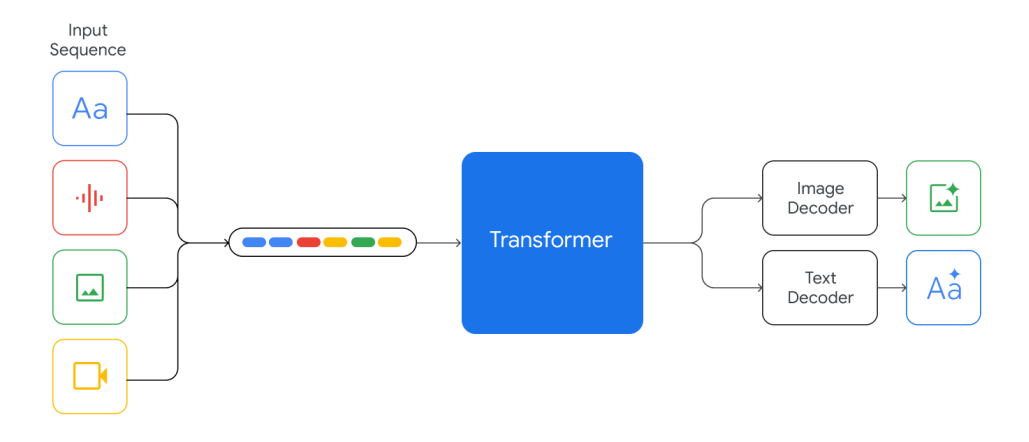
Video understanding in Gemini models involves encoding the video as a sequence of frames within the large context window. Video frames or images can seamlessly integrate with text or audio inputs. The models can adapt to variable input resolution to allocate more compute resources to tasks requiring fine-grained understanding. Additionally, Gemini models can directly process audio signals at 16kHz from the Universal Speech Model (USM) capturing nuances often lost in naive audio-to-text mapping.
Training the Gemini family of models necessitated innovations in training algorithms, datasets, and infrastructure. Leveraging scalable infrastructure and learning algorithms, the Pro model's pre-training can be completed in a matter of weeks, utilizing a fraction of Ultra's resources. The Nano series of models utilize advancements in distillation and training algorithms to produce small language models suitable for various tasks, such as summarization and reading comprehension, powering next-generation on-device experiences.
1. Obtaining an API key for Gemini API
To get started with the Gemini API, you'll need to obtain an API key from the Google Cloud Platform. This key serves as your authentication mechanism, allowing you access to the Gemini API's functionalities.
Obtaining an API key is a straightforward process that involves creating a project on the Google Cloud Platform, enabling the Gemini API, and generating an API key associated with your project. This key will be used in your application to authenticate requests and access Gemini API endpoints securely. You can also create a free by visiting your Google AI Studio.
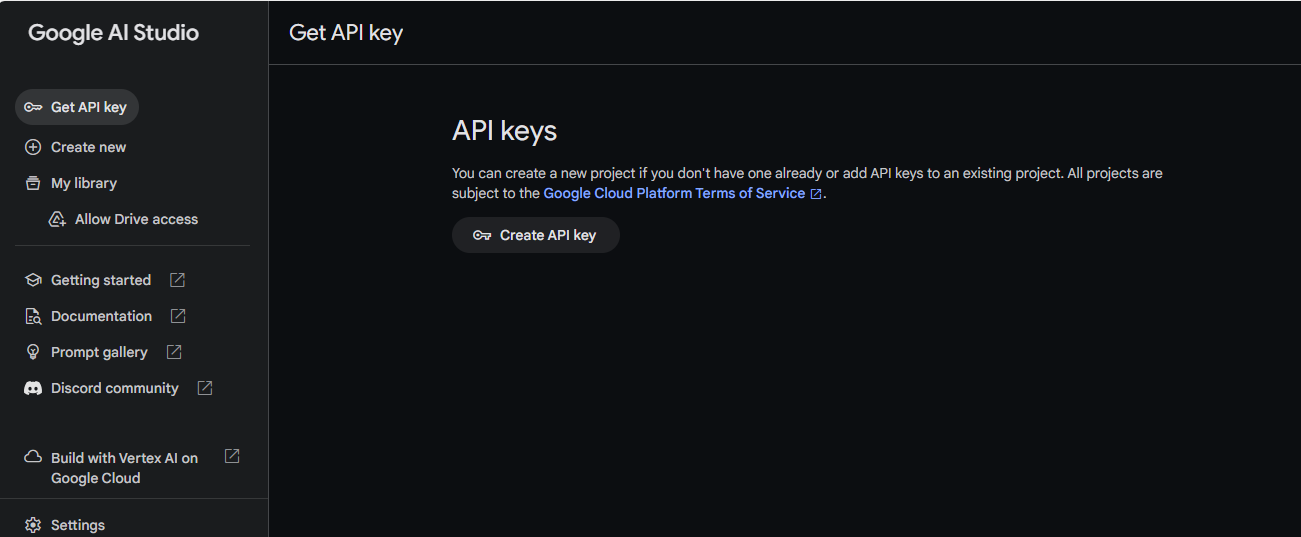
If you are thinking of integrating Gemini into your app, the syntax may look as mentioned below for response generation in different programming languages.
Python
To integrate Gemini API using Python, you can use the below code.
Code
model = genai.GenerativeModel(model_name="gemini-pro-vision")
response = model.generate_con
Android Kotlin
To integrate Gemini API using Android (Kotlin), you can use the below code.
Code
val model = GenerativeModel("gemini-pro-vision")
val response = model.generateContent(content {
text("What's in this photo?")
image(ingredientsBitmap)
})
Node.js
To integrate Gemini API using Node.js, you can use the below code.
Code
const model = genAI.getGenerativeModel({ model: "gemini-pro-vision"});
const result = await model.generateContent([
"What's in this photo?",
{inlineData: {data: imgDataInBase64, mimeType: 'image/png'}}
]);
Swift
To integrate Gemini API using Swift, you can use the below code.
Code
let model = GenerativeModel(name: "gemini-pro-vision")
let response = try await model.generateContent("What's in this photo?", image)
Go
Code
model := client.GenerativeModel("gemini-pro-vision")
resp, err := model.GenerateContent(
ctx,
Chennai.Text("What's is in this photo?"),
Chennai.ImageData("jpeg", imgData))
Web
To integrate Gemini API using the Web, you can use the below code.
Code
const model = genAI.getGenerativeModel({ model: "gemini-pro-vision"});
const result = await model.generateContent([
"What's in this photo?",
{inlineData: {data: imgDataInBase64, mimeType: 'image/png'}}
]);
2. Installing the Python SDK for Gemini API
Once you have obtained your API key, the next step is to install the Python SDK for the Gemini API. The Python SDK provides a set of tools and libraries that simplify interaction with the Gemini API, allowing you to integrate its capabilities into your chatbot development workflow seamlessly.
Installing the Python SDK is as simple as using the pip package manager to install the necessary dependencies available at google-generativeai package. With the Python SDK installed, you'll have access to a wide range of functionalities offered by the Gemini API, empowering you to build powerful and intelligent chatbots.
The syntax for installing Python SDK is as follows:
pip install -q -U google-generativeai

3. Setting up necessary dependencies
In addition to the Python SDK for the Gemini API, you'll also need to set up other dependencies required for your chatbot development environment. These dependencies may include libraries for natural language processing, machine learning, and web development frameworks, depending on the specific requirements of your chatbot project. Ensuring that all necessary dependencies are properly installed and configured is essential for the smooth functioning of your chatbot and the successful integration of the Gemini API. By setting up the necessary dependencies beforehand, you'll be well-prepared to embark on your chatbot development journey with confidence and efficiency.
Designing Your Chatbot
The journey of building a chatbot using the Gemini API opens doors to enhanced customer interactions and streamlined processes. This section delves into the crucial steps of conceptualizing and designing your chatbot to align with your business goals and user needs.
1. Defining the Objectives and Functionality of Your Chatbot
Before diving into development, articulate clear objectives and functionalities for your chatbot. Determine its primary purpose, whether it's customer support, lead generation, or information dissemination. Define specific features and capabilities, such as natural language understanding, sentiment analysis, or integration with backend systems, to ensure your chatbot effectively meets user needs.
2. Identifying Potential Use Cases and User Scenarios
Understanding the context in which your chatbot will operate is essential for its success. Identify potential use cases across various touchpoints, from website assistance to social media engagement.
Analyze user scenarios to anticipate their needs and preferences, ensuring your chatbot provides relevant and valuable interactions tailored to different contexts and user intents.
3. Designing the Conversational Flow and User Interface
Crafting a seamless conversational flow and intuitive user interface is paramount for a user-friendly chatbot experience. Map out dialogue paths, considering different user inputs and potential responses. Design a user interface that is visually appealing, easy to navigate, and aligns with your brand identity. Prioritize clarity and simplicity to facilitate smooth interactions and enhance user engagement. This can be quickly achieved by hiring an AI development company, as they have all the resources and market updates on user behavior and products the market needs to solve the problem
Implementing Your Chatbot in Your App
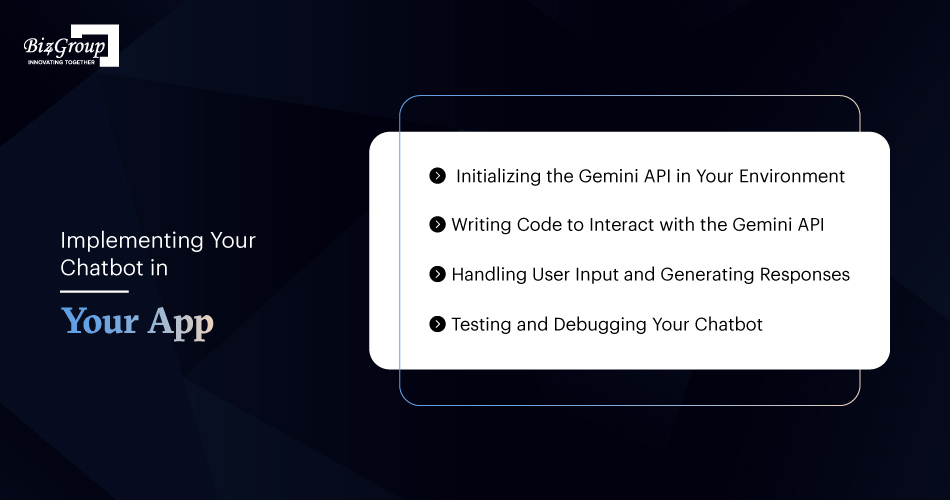
Embarking on implementing your chatbot using the Gemini API is an exciting journey into the realm of conversational AI. This section will guide you through the process of initializing the Gemini API, writing code to interact with it, handling user input, and testing your chatbot for optimal performance.
1. Initializing the Gemini API in Your Environment
To kickstart your chatbot project, you need to initialize the Gemini API within your development environment. Begin by obtaining your API key for Gemini, which grants access to its powerful features. With the API key secured, you'll proceed to install the Python SDK (if you are a Python developer) for Gemini API using the `google-generativeai` package via pip, ensuring seamless integration.
2. Writing Code to Interact with the Gemini API
With the Gemini API set up in your environment, the next step is to write code that interacts with the API. Utilizing the Python SDK, you'll be able to leverage Gemini's extensive capabilities for conversational AI. This involves importing the necessary modules, establishing connections to the API, and defining functions to handle various chatbot functionalities.
3. Handling User Input and Generating Responses
User interaction lies at the heart of any chatbot, and with the Gemini API, handling user input and generating meaningful responses becomes streamlined. Your code will need to capture user messages, process them using Gemini's language models, and craft appropriate responses. This involves implementing logic to interpret user queries, understand context, and generate coherent replies.
4. Testing and Debugging Your Chatbot
Before deploying your chatbot into production, thorough testing and debugging are essential to ensure its functionality and performance. You'll conduct various tests, including unit tests to validate individual components, integration tests to assess interactions with the Gemini API, and end-to-end tests to evaluate the overall user experience. Debugging will involve identifying and resolving any issues or errors that arise during testing.
Advanced Features and Customization
As you delve deeper into building your chatbot with Gemini API, explore its advanced features and customization options. Unlock the full potential of your chatbot by leveraging Gemini's capabilities for enhanced language understanding, multimedia integration, and tailored responses.
1. Leveraging Gemini API's Advanced Language Understanding Capabilities
Harness the power of Gemini API's advanced language understanding capabilities to create a chatbot that truly understands and responds to user queries with accuracy and fluency. With state-of-the-art machine learning algorithms, Gemini interprets natural language input, enabling your chatbot to engage in meaningful and contextually relevant conversations, driving user satisfaction and retention.
2. Integrating Multimedia Content and Multimodal Interactions
Enhance user engagement and interaction by integrating multimedia content and enabling multimodal interactions within your chatbot powered by Gemini API. Seamlessly incorporate images, videos, and other multimedia elements into the conversation flow, enriching the user experience. With Gemini's support for both text and image inputs, your chatbot can provide more comprehensive responses, catering to diverse user preferences and needs.
3. Customizing Your Chatbot's Responses and Behavior
Tailor your chatbot's responses and behavior to align with your brand identity and user expectations, leveraging the customization options offered by Gemini API. Define personalized conversational styles, tone, and language preferences to create a unique user experience. With Gemini's flexibility, you can fine-tune your chatbot's responses for specific use cases, ensuring relevance and effectiveness in addressing user inquiries and requests.
Deployment and Scaling
Deployment and scaling are crucial steps when you think of developing a chatbot. This section guides you through deploying your chatbot to a production environment, ensuring scalability, and maintaining its performance over time.
1. Deploying Your Chatbot to a Production Environment
To deploy your chatbot powered by Gemini API to a production environment, start by ensuring that your application adheres to Google Cloud's deployment standards. Utilize the Gemini REST API to integrate your chatbot seamlessly. With Google Cloud's robust infrastructure, deploying your chatbot becomes a streamlined process. Ensure that you have the necessary permissions and credentials to access the Gemini API within your production environment.
2. Ensuring scalability and performance optimization
Scalability is key to ensuring that your chatbot can handle varying levels of user demand. Utilize Google Cloud's auto-scaling capabilities to automatically adjust resources based on traffic fluctuations. Additionally, optimize your chatbot's performance by implementing caching mechanisms, minimizing latency, and optimizing resource utilization. Regularly monitor performance metrics to identify bottlenecks and optimize resource allocation for enhanced scalability.
3. Monitoring and Maintaining Your Chatbot Over Time
Continuous monitoring and maintenance are essential to ensure the reliability and efficiency of your chatbot. Implement monitoring solutions provided by Google Cloud to track key performance indicators such as response time, error rates, and resource utilization. Set up alerts to promptly identify and address any issues that may arise. Regularly update your chatbot with new features, improvements, and security patches to ensure it remains up-to-date and meets evolving user needs. Regular maintenance and updates will help maximize the longevity and effectiveness of your chatbot built with Gemini API.
What are the Best Practices and Tips to keep in Mind?
When crafting a chatbot using the Gemini API, it's vital to adhere to best practices for optimal performance and user satisfaction. This section outlines key strategies to enhance your chatbot's functionality, security, and user experience.

1. Designing an Intuitive User Experience
To create an engaging chatbot experience, prioritize simplicity and clarity in your user interface. Ensure seamless navigation, concise messaging, and intuitive prompts to guide users effectively. Incorporate visual elements and interactive features judiciously to enhance engagement and streamline user interactions.
2. Ensuring Data Privacy and Security
Protecting user data is paramount when developing a chatbot. Implement robust security measures, such as encryption protocols and access controls, to safeguard sensitive information. Adhere to data privacy regulations and regularly audit your system for vulnerabilities to maintain trust and compliance with legal standards.
3. Incorporating Feedback Loops for Continuous Improvement
Feedback loops are essential for refining and optimizing your chatbot over time. Encourage user feedback through surveys, ratings, and user analytics to identify pain points and areas for improvement. Continuously iterate on your chatbot's design, functionality, and responses based on user input to enhance its performance and user satisfaction.
Conclusion
In conclusion, this guide has provided a comprehensive overview of building chatbots using the Gemini API, a powerful tool within the Google Cloud ecosystem. We've explored key concepts such as setup, implementation, and customization, emphasizing the versatility and advanced capabilities of Gemini. Encouraging readers to leverage the Google chatbot API for innovative solutions, we highlight its potential to revolutionize customer interactions.
Looking ahead, the future of chatbot technology, driven by advancements in the Gemini REST API, promises even greater sophistication and effectiveness. Now equipped with the knowledge of how to use the Gemini API, readers are primed to embark on their journey towards creating intelligent chatbots.
FAQs
1. What is the Gemini API?
The Gemini API is a powerful tool provided by Google Cloud Platform (GCP) for building intelligent chatbots. It offers advanced language models for tasks like conversational AI, text summarization, question answering, and text generation.
2. How do I obtain an API key for the Gemini API?
You can obtain an API key for the Gemini API by visiting Google AI Studio and creating one with just a click.
3. Can I integrate multimedia content into my chatbot with Gemini API?
Yes, Gemini API excels at handling both text and image inputs, enabling you to create chatbots that understand images alongside user inquiries, enriching the conversational experience.
4. What programming language can I use to implement my chatbot with Gemini API?
You can use Python to implement your chatbot with Gemini API. The Python SDK for Gemini API is available in the google-generativeai package, which you can install using pip.
5. Is Gemini API suitable for scalable and production-ready chatbots?
Absolutely, Gemini API is hosted on Google Cloud's Vertex AI platform, providing the scalability needed to handle large volumes of chatbot interactions. It integrates seamlessly with other GCP services like Cloud Storage, Cloud Functions, and Cloud Run, making it suitable for production environments.
 info@biz4group.com
info@biz4group.com 
















































